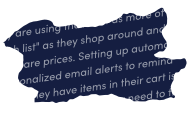Retention rate is a metric that refers to the percentage of returning customers to a business, service, or product. The retention rate for a subscription service is the percentage of customers who stay subscribed month after month. For a product (usually consumables such as food or clothing), it refers to consumers who prefer your brand to competitors and return to make repeat purchases.
What is retention rate?
Retention rate is a marketing metric that measures the long-term success and relevancy of consumable products and subscription services. It is defined as the percentage of customers who subscribe to a single service or repeatedly purchase the same item over time. For many businesses, the retention rate is an essential measurement.
However, companies selling long-lasting products like cars or machinery may not see retention rate as a key metric. Most measurements of retention rate look at one-year periods. It’s uncommon for someone to purchase multiple cars in a single year. Where those companies do look at retention rates is with warranties or maintenance agreements.
Retention rate is affected by customer satisfaction, product/service success, how much customers rely on what you provide, and how difficult it is for customers to leave. In many cases, the last aspect may not apply. Still, some service providers, especially in the Telecom industry, benefit from being the only option available in a region or creating contracts that penalize consumers from canceling service or switching providers.
Retention rate is the opposite of churn rate since the churn rate is the number of customers a company loses over a predetermined period. Seeing a low retention rate or high churn rate can indicate that the service or product isn’t meeting consumer needs or customers aren’t having positive experiences with your company since they are trying out the service/product and then canceling.
Why is retention rate important?
There are several reasons why retention rate is a popular metric to measure the success of a brand or product, including:
- Provides an ongoing indicator of consumer satisfaction: Launching a new product or service is a complex, costly, and often risky process. A high retention rate for an existing product or service demonstrates that it is still relevant in today’s market and may not need to be replaced or modified since it’s continuing to meet consumer needs.
- Helps to identify areas for improvement: If you notice your retention rate dropping after a certain change, such as a product update, a particular season or holiday, or a new competitor on the market, you may be able to understand why your customers are churning and make improvements.
- Increases profits: Acquiring new consumers is expensive, significantly more than retaining existing ones. A high retention rate means you are continuing to generate revenue, at a lower investment, which leads to higher profit margins.
- Encourages cross-purchases: These return customers are likelier to purchase other services or products from your business because are already loyal to the brand. This can be a valuable source of added revenue.
How do you calculate retention rate?
To calculate retention rate, first define a measurement period, typically one year. Once you’ve established the timeframe, look at how many customers you had at the beginning of the period, how many people signed up/began purchasing your product during the period (New), and how many customers you had at the end of the period (End).
The retention rate formula is as follows: ((End – New) / Start) X 100
For example, say you began a one-year period with 282 customers (Start). During the year, you got 45 new customers (New). By the end of the year, you had 265 customers (End). That would plug into the formula as ((265 – 45) / 282) X 100 = 78%. Even though you ended with fewer customers, you still have a 78% retention rate, which is decent in most industries.
From there, you can dive deeper into calculating retention rates by using one of two methods of cohort analysis. With cohort analysis, you can divide customers into smaller groups (cohorts) based on one or more shared attributes, such as how they interact with a product, where they live, when they started using your service, or language.
Acquisition cohorts are groups based on when users signed up for your service or started using your product. By looking at retention rates based on acquisition, you can identify times when retention fluctuated. If people who signed up in April have the highest retention rate, you could organize your marketing strategies to concentrate on acquiring new customers in April.
Conversely, behavioral cohorts are groups based on how users interact with your service or product. For example, The New York Times app could separate users based on whether or not they do the daily crossword puzzles, or Netflix could make groups that reflect how many hours per week they watch Netflix shows.
Behavioral cohorts provide information about which types of behaviors are connected to long-term retention. For example, if people who work on the crossword puzzle continue to subscribe to The New York Times, the company might choose to advertise that feature of the app.
What is a good retention rate?
Retention rates vary widely by industry. For example, in retail, 63% would be considered a good retention rate because there is so much competition, and there is little incentive for customers not to switch brands. On the other hand, the acquisition costs are often quite low in retail, so having a lower retention rate doesn’t necessarily mean a business is unsuccessful.
In contrast, Telecom companies see 78% as the minimum retention rate because it is so difficult to switch providers. In many areas, alternative providers may not exist. Even when they do, all of the major providers offer the same services, so there’s no concrete incentive for a consumer to switch unless they become dissatisfied with their current provider.
Industries with higher average retention rates tend to be ones where there are few to no alternatives available, or it is challenging to switch to another provider. Media, such as streaming services, tend to set a good retention rate at around 84% because if a consumer wants to watch a specific show, it’s typically only available on one streaming service.
Other reasonable retention rates include
- IT Services: 81%
- Banking: 75%
- Insurance: 83%
How to improve retention rate
Considering how critical retention rates are for many companies, it’s no surprise that marketers are constantly looking to improve retention rates. Here are a few key strategies to boost retention rate:
- Use retention software: Retention software can help mitigate certain problems like credit card failure, define audience groups, manage support tickets, message customers, and track retention data over time. With the right software, your business can gain insights about when customers churn and identify potential areas for improvement.
- Ask for customer feedback: Soliciting consumer feedback through exit surveys, pop-up messages, and surveys at the end of a customer service chat or phone call are all ways to learn more about how satisfied customers are with your brand or product. Typically, customers who are upset or frustrated are more likely to fill out surveys or leave poor reviews on websites like Yelp, which can provide valuable information about areas to improve.
- Make improvements: When you identify pain points through customer feedback or retention data, implement changes to fix those issues. If customers complain about how long they’re on hold with Customer Service, your business could hire more representatives, employ a chatbot to answer questions, provide community forums or FAQs, or take other actions to address the problem.
- Encourage retention at signup: A common practice for service providers is giving discounts for subscribing for longer. For example, you might charge $5 for a monthly subscription but $50 for an annual subscription or include additional services as bonuses when someone signs up for an extended period.
- Reward long-term customers: Show repeat customers that you appreciate their business and loyalty by offering rewards and perks. Examples include faster or cheaper shipping, promo codes, or access to special, subscription-only options. You can also send out discount codes for customer birthdays or sign-up anniversaries.
- Connect with customers: Consumers are much more likely to trust and forgive companies that offer a human touch. Determine where your customers are (Twitter, LinkedIn, Snapchat, etc.) and encourage them to connect with the brand. Reach out with light humor and respond publicly to questions and complaints. Even if you’re connecting through emails or phone calls, add a personal touch, so customers don’t feel like they’re only talking to robots.
- Focus on customer satisfaction: Offering a great product or service is only half the battle; you must also keep your customers satisfied over time. No matter how amazing the service is, things can and will go wrong. With good customer service and fast response times, you can mitigate a lot of potential issues and keep the customer coming back for more. Similarly, if your company makes a mistake, always apologize and rectify the situation.


